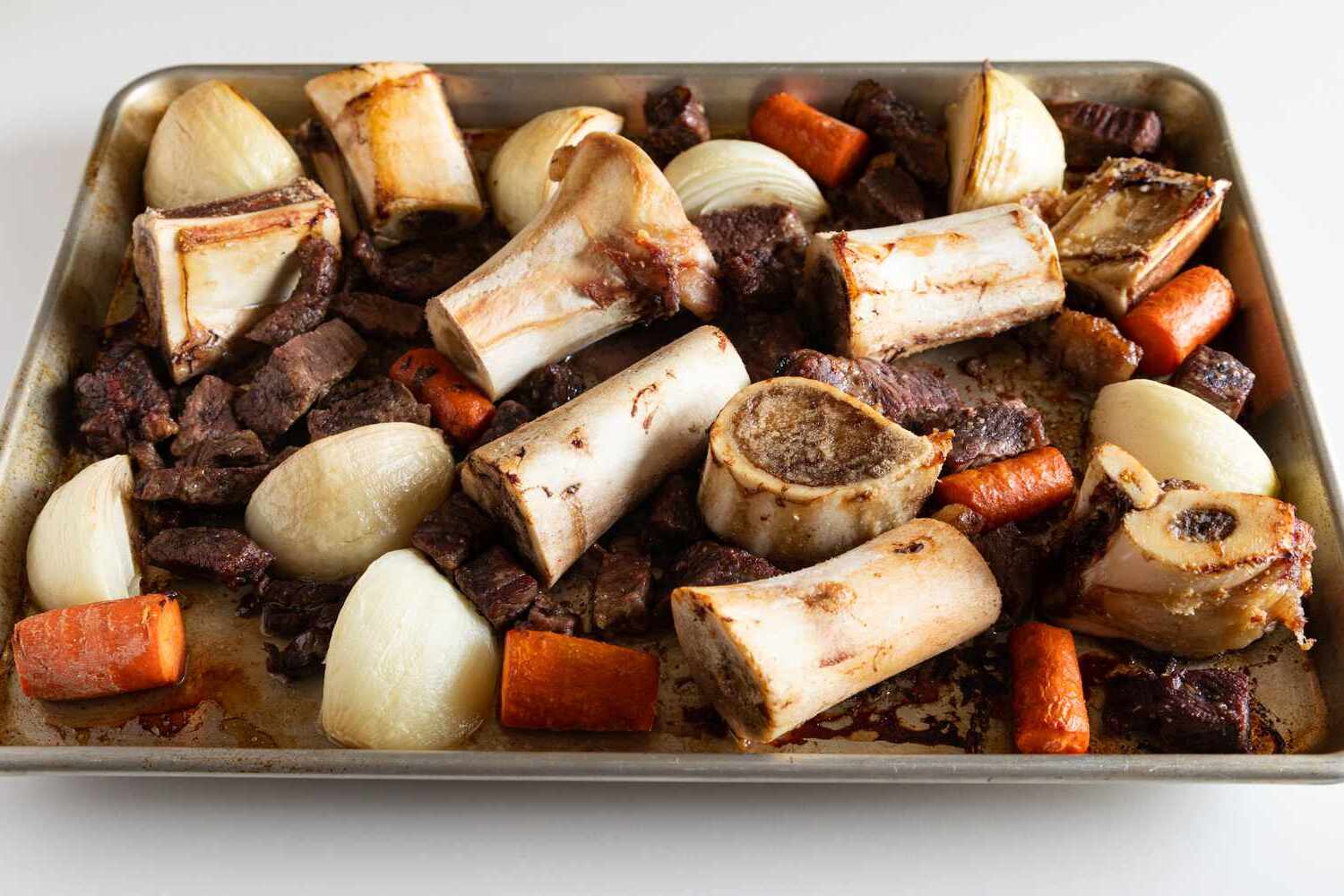Creating a rich and nourishing beef bone broth at home is a rewarding experience. This recipe yields a flavorful broth that can be used as a base for soups, stews, or enjoyed on its own. The long simmering time extracts maximum flavor and nutrients from the beef bones, resulting in a deeply satisfying and healthful broth.
When preparing this recipe, you may need to visit a butcher or a well-stocked supermarket to find beef bones, preferably with marrow. Apple cider vinegar is another ingredient that might not be in everyone's pantry, but it plays a crucial role in helping to extract minerals from the bones. Make sure to get fresh vegetables like carrots, celery, and onion to enhance the flavor of the broth.

Ingredients for Beef Bone Broth Recipe
Beef bones: The foundation of the broth, providing rich flavor and nutrients.
Carrots: Adds sweetness and depth to the broth.
Celery: Contributes a subtle, aromatic flavor.
Onion: Enhances the overall taste with its savory notes.
Garlic: Adds a robust, aromatic element.
Apple cider vinegar: Helps to extract minerals from the bones.
Salt: Enhances the flavors of the ingredients.
Pepper: Adds a hint of spice and complexity.
Water: The base liquid that turns into the broth.
Technique Tip for Beef Bone Broth
Roasting the beef bones at a high temperature before simmering helps to develop a deeper, richer flavor in your broth. Make sure to spread the bones out in a single layer on the baking sheet to ensure even browning.
Suggested Side Dishes
Alternative Ingredients
beef bones - Substitute with chicken bones: Chicken bones can provide a rich and flavorful broth, though it will have a lighter taste compared to beef.
beef bones - Substitute with pork bones: Pork bones can also create a hearty broth, though it will have a slightly different flavor profile.
carrots - Substitute with parsnips: Parsnips have a similar texture and sweetness, making them a good alternative to carrots.
celery - Substitute with fennel: Fennel has a similar crunchy texture and adds a slightly different but complementary flavor.
onion - Substitute with leeks: Leeks provide a milder onion flavor and can add a subtle sweetness to the broth.
garlic - Substitute with shallots: Shallots offer a milder, sweeter flavor compared to garlic, but still add depth to the broth.
apple cider vinegar - Substitute with white wine vinegar: White wine vinegar has a similar acidity and can help extract nutrients from the bones.
apple cider vinegar - Substitute with lemon juice: Lemon juice provides the necessary acidity and adds a fresh, citrusy note to the broth.
salt - Substitute with soy sauce: Soy sauce can add saltiness along with a rich umami flavor.
pepper - Substitute with white pepper: White pepper has a similar heat but a slightly different flavor, which can add a unique twist to the broth.
water - Substitute with vegetable broth: Using vegetable broth instead of water can add extra layers of flavor to the final broth.
Other Alternative Recipes Similar to This
How To Store / Freeze This Recipe
- Allow the beef bone broth to cool to room temperature before storing. This helps prevent condensation and bacterial growth.
- Use airtight containers or mason jars to store the broth. Make sure they are clean and dry to maintain the broth's freshness.
- For short-term storage, refrigerate the broth. It will keep well for up to 5 days. Label the containers with the date to keep track of freshness.
- For long-term storage, consider freezing the broth. Use freezer-safe containers or heavy-duty freezer bags. Leave some space at the top of the containers as the broth will expand when frozen.
- If using freezer bags, lay them flat in the freezer to save space and allow for quicker thawing.
- For convenience, freeze the broth in smaller portions, such as in ice cube trays. Once frozen, transfer the cubes to a freezer bag. This allows you to use small amounts as needed.
- When ready to use, thaw the broth in the refrigerator overnight or use the defrost setting on your microwave.
- Reheat the broth on the stove over medium heat until it reaches a simmer. Avoid boiling to preserve the delicate flavors.
- If you notice any off smells or changes in color, discard the broth as it may have spoiled.
- For added flavor, consider adding fresh herbs or spices when reheating the broth.
How To Reheat Leftovers
Gently reheat your beef bone broth on the stovetop. Pour the desired amount into a saucepan and warm over medium heat until it reaches your preferred temperature. Stir occasionally to ensure even heating.
Use a microwave for a quick option. Pour the broth into a microwave-safe bowl, cover it with a microwave-safe lid or plate, and heat on high for 1-2 minutes. Stir halfway through to distribute the heat evenly.
For a slow and steady approach, reheat the broth in a slow cooker. Set it to low and let it warm up for about 1-2 hours. This method is perfect if you want to keep the broth warm for an extended period.
If you're planning to use the broth as a base for soups or stews, add it directly to your pot of ingredients and bring everything to a simmer. This way, the broth will heat up as the other ingredients cook.
For a more flavorful twist, reheat the broth with additional aromatics. Add a sprig of fresh thyme, a few slices of ginger, or a dash of soy sauce while warming it on the stovetop. This can enhance the depth of flavor.
If you have frozen portions of broth, thaw them overnight in the refrigerator before reheating using any of the above methods. Alternatively, you can place the frozen broth directly into a saucepan and heat over low heat until fully thawed and warmed.
Best Tools for Making Beef Bone Broth
Oven: Used to roast the beef bones at 400°F (200°C) to enhance their flavor before simmering.
Baking sheet: A flat surface to place the beef bones on while roasting in the oven.
Large pot: Essential for holding the roasted bones, vegetables, and water while simmering the broth.
Chopping board: Provides a stable surface for chopping the carrots, celery, and onion.
Knife: Used to chop the vegetables and quarter the onion.
Garlic press: Useful for smashing the garlic cloves, though you can also use the flat side of a knife.
Measuring spoons: Needed to measure out the apple cider vinegar, salt, and pepper accurately.
Fine-mesh strainer: Used to strain the broth, ensuring a clear liquid by removing solids.
Large bowl: Catches the strained broth from the fine-mesh strainer.
Refrigerator: Used to cool the broth, allowing the fat to solidify for easy removal.
Spoon: Handy for skimming off any foam or fat that rises to the top during simmering.
Ladle: Useful for transferring the broth from the pot to the fine-mesh strainer.
How to Save Time on Making This Recipe
Roast in batches: If your oven is small, roast the beef bones in batches to save time.
Use a slow cooker: Instead of simmering on the stove, use a slow cooker to cook the broth overnight.
Pre-chop vegetables: Chop the carrots, celery, and onion in advance and store them in the fridge.
Quick cool method: To cool the broth faster, place the bowl in an ice bath before refrigerating.
Skim efficiently: Use a fine-mesh skimmer to quickly remove foam and fat during simmering.

Beef Bone Broth Recipe
Ingredients
Main Ingredients
- 4 lbs Beef bones preferably with marrow
- 2 large Carrots chopped
- 2 stalks Celery chopped
- 1 large Onion quartered
- 3 cloves Garlic smashed
- 2 tablespoon Apple cider vinegar
- 1 teaspoon Salt to taste
- 1 teaspoon Pepper to taste
- 16 cups Water
Instructions
- 1. Preheat your oven to 400°F (200°C). Place the beef bones on a baking sheet and roast for 30 minutes.
- 2. Transfer the roasted bones to a large pot. Add the carrots, celery, onion, garlic, apple cider vinegar, salt, and pepper.
- 3. Pour in the water, making sure the bones and vegetables are fully submerged. Bring to a boil, then reduce to a simmer.
- 4. Simmer for at least 12 hours, skimming off any foam or fat that rises to the top.
- 5. Strain the broth through a fine-mesh strainer into a large bowl. Discard the solids.
- 6. Let the broth cool, then refrigerate. Once chilled, remove any solidified fat from the top.
Nutritional Value
Keywords
More Amazing Recipes to Try 🙂
- Slow Cooker Chili Recipe8 Hours 15 Minutes
- Summer Squash Bread Recipe1 Hours 15 Minutes
- Apple Cider Recipe40 Minutes
- Watermelon Lemonade Recipe10 Minutes
- Electric Lemonade Recipe10 Minutes
- Turkey Wraps Recipe10 Minutes
- Fresh Banana Daiquiri Recipe10 Minutes
- Cosmopolitan Recipe5 Minutes

Leave a Reply